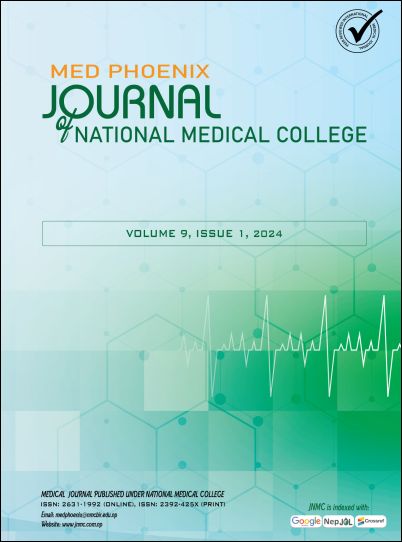Gender Differences in Lipid Profile in Dyslipidemic Patients Visiting Hetauda Hospital
DOI:
https://doi.org/10.3126/medphoenix.v9i1.67178Keywords:
Cholesterol, Dyslipidemia, Gender, TriglycerideAbstract
Introduction: Dyslipidemia has long been considered as one of the risk factors of cardiovascular disease. There are limited data on risk factor stratification at community level in our region. This hospital-based research has provided an insight to gender as the latent burden of risk factor and laid the groundwork for making strategies for policymakers and future prospective research.
Materials and Methods: This study employed the retrospective design with census sampling and included 7,922 patients sent for lipid profile test over the duration of seven months. Demographic information and lipid profile data were extracted from the hospital records. Subgroup analysis of dyslipidemic patients according to gender and age (≤ 50 years and > 50 years) was done. Ratios of total cholesterol to high density lipoprotein, triglyceride to high density lipoprotein and non-high-density lipoprotein were also calculated and analyzed among groups.
Results: Among the 7,922 patients included in the study, (6546) 82.63% were diagnosed with dyslipidemia. Gender-wise distribution revealed that 42.08% of dyslipidemic patients were male, while 57.92% were female. Females exhibited significantly higher levels of total cholesterol (p < 0.001), LDL cholesterol (p < 0.001), and non-HDL cholesterol (p < 0.01) compared to males. Conversely, males showed significantly higher levels of triglycerides and TC/HDL ratio (p < 0.01). Age-wise analysis indicated distinct patterns: In the ≤ 50 years age group, males displayed significantly deranged lipid profiles and ratios compared to females. However, in the > 50 years age group, females exhibited significantly higher levels of total cholesterol, triglycerides, LDL cholesterol, and non-HDL cholesterol compared to males. Notably, a higher number of males (557) displayed increased triglyceride and decreased HDL in tandem compared to females (492).
Conclusion: The study showed increased prevalence of dyslipidemia and highlighted the apparent gender specific disparities in lipid profile in people residing in the catchment area of provincial hospital.
Downloads
Downloads
Published
How to Cite
Issue
Section
License
Copyright (c) 2024 Med Phoenix

This work is licensed under a Creative Commons Attribution-NonCommercial 4.0 International License.
This license enables reusers to distribute, remix, adapt, and build upon the material in any medium or format, so long as attribution is given to the creator.
Copyright on any research article is transferred in full to MED PHOENIX upon publication. The copyright transfer includes the right to reproduce and distribute the article in any form of reproduction (printing, electronic media or any other form).




